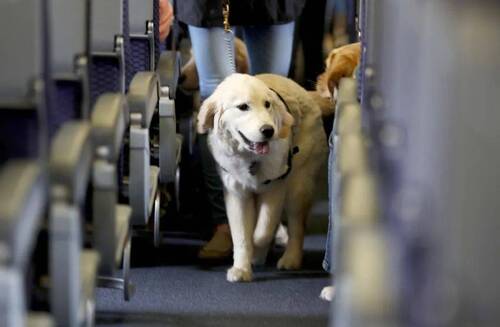Service animals are animals that are specially trained to help people with disabilities complete daily life tasks. They are considered important in many countries. Assistive tools help people with specific needs improve their quality of life. This article will introduce in detail the definition, types, functions and help of service animals in human life.

What is a service animal?
A service animal is a specially trained animal that helps individuals with disabilities, mental health issues, or specific health needs perform tasks of daily living. These tasks include, but are not limited to: assisting with mobility, providing medication reminders, detecting seizures, providing emotional support, etc. The most common service animals are dogs, but other animals, such as horses and cats, can also serve in this capacity in certain situations. Role.
Service animals can perform tasks such as physical assistance, emotional support, medical testing, etc., and can provide Training helps owners overcome physical or psychological limitations. The legal status of service animals is protected by law in many countries, such as the Americans with Disabilities Act (ADA) and other similar laws and regulations in the United States.
The difference between service animals and pets
The difference between service animals and ordinary pets is that they are professionally trained and not only serve as companions, but also provide substantial services to their owners. Help. The main function of ordinary pets is entertainment and companionship, while service animals have clear job responsibilities and their service objects are usually people with disabilities or health problems.
Legal Protections for Service Animals
In many countries, service animals have certain rights, such as:
Access to public places: Service animals can enter public places such as restaurants, hospitals, and stores, even if these places usually do not allow pets.
Right to use transportation: Service animals can travel with their owners on airplanes, trains, buses and other transportation.
No Extra Fees: Service animals do not incur additional fees for stay or ride, and are generally not required to be on a leash.
Types of Service Animals
There are many types of service animals, and they can be divided into many categories depending on the tasks they perform. Here are some of them: The most common service animals and their functions:
1. Guide Dogs
Purpose: Guide dogs are dogs that help visually impaired or blind people with their daily activities. They help their owners identify roads, avoid obstacles, and ensure safe travel.
Training: Guide dogs undergo rigorous professional training and are able to work in complex urban environments, such as crossing roads and entering buildings.
Common breeds: Golden Retrievers, Labrador Retrievers and other breeds are often chosen as guide dogs because of their gentle temperament, intelligence and ease of training.
2. Hearing Dogs
Function: Hearing dogs help hearing-impaired or deaf owners perceive sounds, especially important sounds that alert the owner, such as doorbells, telephones, fire alarms, etc. They can alert the owner to potential dangers through body language and behavior.
Common breeds: Hearing dogs are usually small in size, and common breeds include Cocker Spaniels, Corgis, etc.
3. Mobility Assistance Dogs
Function: Mobility assistance dogs help owners who are mobility-impaired or use wheelchairs to complete daily tasks, such as opening and closing doors, picking up objects, and pressing elevator buttons. They can also provide support and help their owners regain balance when they fall.
Common breeds: Large breeds such as Labrador Retrievers and German Shepherds are often used as mobility assistance dogs because of their greater strength and strong training ability.
4. Medical Alert Dogs
Function: Medical alert dogs can detect and alert their owners to certain health conditions in advance, such as changes in blood sugar in diabetics, epileptic seizures, and heart attacks. They use their sense of smell to identify changes in body chemicals and give warnings before the disease occurs.
Common Uses: Diabetic alert dogs and epilepsy alert dogs are more common types of medical alert dogs.
5. Psychiatric Service Dogs
Role: Psychiatric service dogs help individuals with psychological or mental illnesses, such as post-traumatic stress disorder (PTSD), depression, anxiety, etc. They relieve emotional fluctuations through interaction with their owners, and can comfort their owners when their emotions are out of control, and even help their owners identify impending mental symptoms.
Common breeds: Any breed of dog can serve as a psychological support dog, but gentle and caring dogs, such as Labradors or Poodles, are more common.
6. Miniature Horses
Purpose: Miniature horses are a miniature breed of horse and can also be used as guide animals, especially for individuals who are allergic to dogs or have other preferences. Miniature horses have a longer lifespan and higher endurance, making them suitable for some people who need long-term assistance.
Common Uses: Miniature horses can help visually impaired people navigate, similar to the role of guide dogs.
7. Emotional Support Animals (ESA)
Function: Emotional support animals help relieve stress, anxiety and other mental illnesses through emotional connection with their owners. Although emotional support animals do not require special task training, they play an important emotional supporting role in the mental health of their owners.
Difference: The difference between emotional support animals and other service animals is that emotional support animals do not have specific work tasks. Their main function is to provide psychological and emotional comfort and companionship.
Function of service animals
The role of service animals is to help people with disabilities overcome difficulties in daily life and improve their independence and safety. Here are some common services that service animals can help with:
Helping with daily life: Many service animals can help with daily tasks, such as fetching items, opening doors, and helping owners walk. Especially for people with disabilities who have limited mobility, mobility assistance dogs can greatly improve their quality of life.
Providing safety: Guide dogs and hearing dogs can improve the safety of their owners when they go out, and help them deal with potential dangers in the environment, such as vehicles and obstacles.
Health monitoring and early warning: Medical warning dogs can detect changes in the owner's health status, warn of disease onset in advance, and help the owner take medical measures in time.
Emotional comfort and mental support: Mental support dogs and emotional support animals help their owners relieve emotional stress and provide emotional comfort through companionship and interaction, helping them cope with mental illnesses such as anxiety and depression.
Enhance independence: Service animals can help people with disabilities be more independent in their lives and no longer rely entirely on the help of others, thereby enhancing their personal confidence and self-esteem.
How to train service animals?
The training of service animals is very strict and usually requires professional trainers to conduct training. The training process may take up to a year or even longer, and includes the following major stages:
Basic behavior training: Service animals first need to master basic obedience commands, such as "sit", "come", "stop", etc.
Specialized skills training: Depending on the needs of the service recipients, animals will receive specific task training, such as guiding the blind, detecting diseases, or helping to complete physical tasks.
Adapting to public environments: Service animals need to get used to various environments, such as streets, shopping malls, transportation, etc., and remain calm and undisturbed.
Only after these trainings can service animals ensure that they can focus on the needs of their owners and perform tasks when faced with various complex scenarios.
Service animals are animals that provide critical assistance to people with disabilities, not only by helping with daily tasks but also by providing emotional support to those in need. Whether they are guide dogs, hearing dogs, medical alert dogs or psychiatric support dogs, they provide people with disabilities with more independence and security, improving their quality of life.








